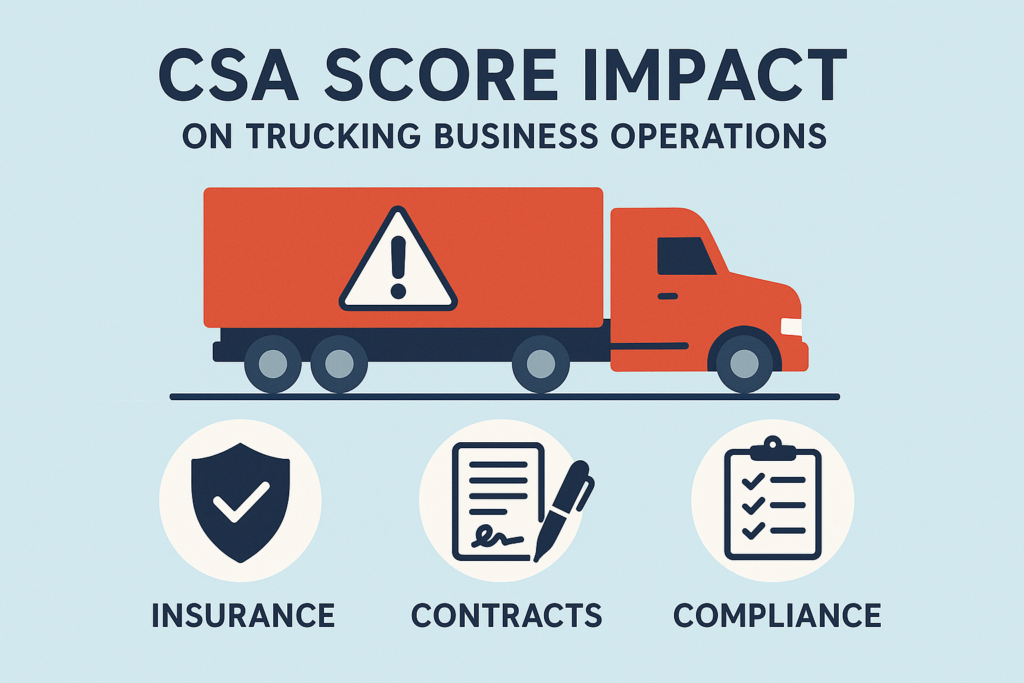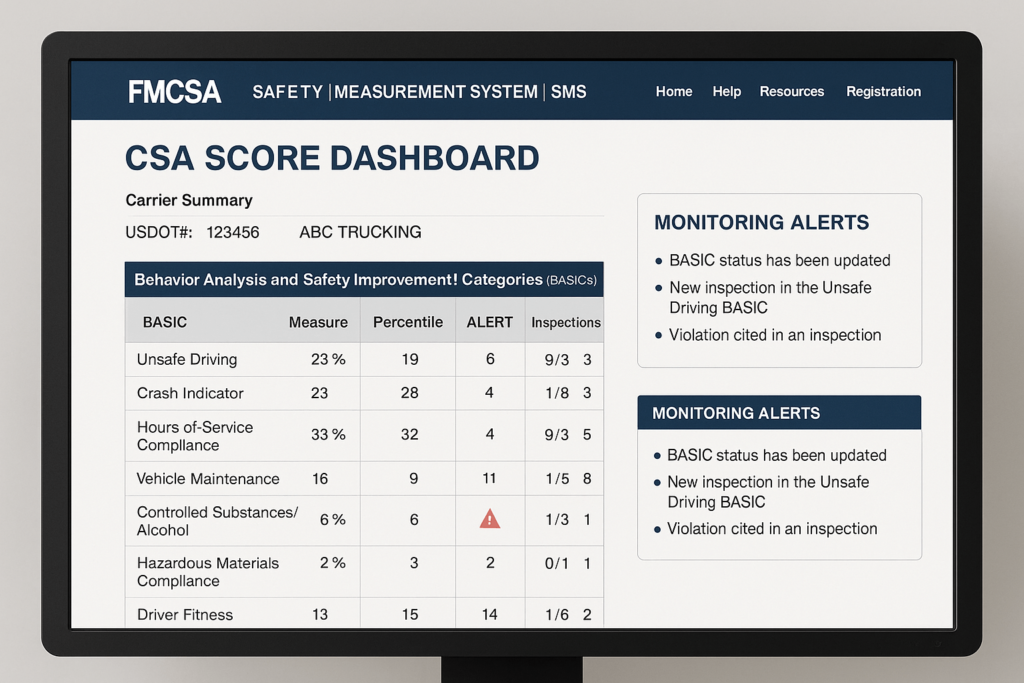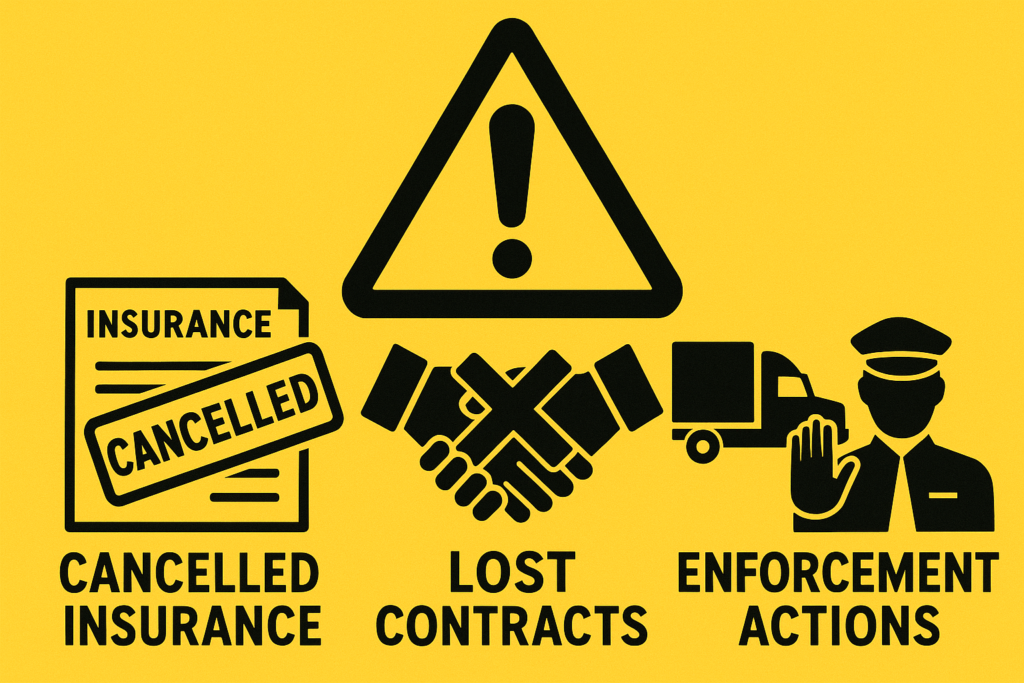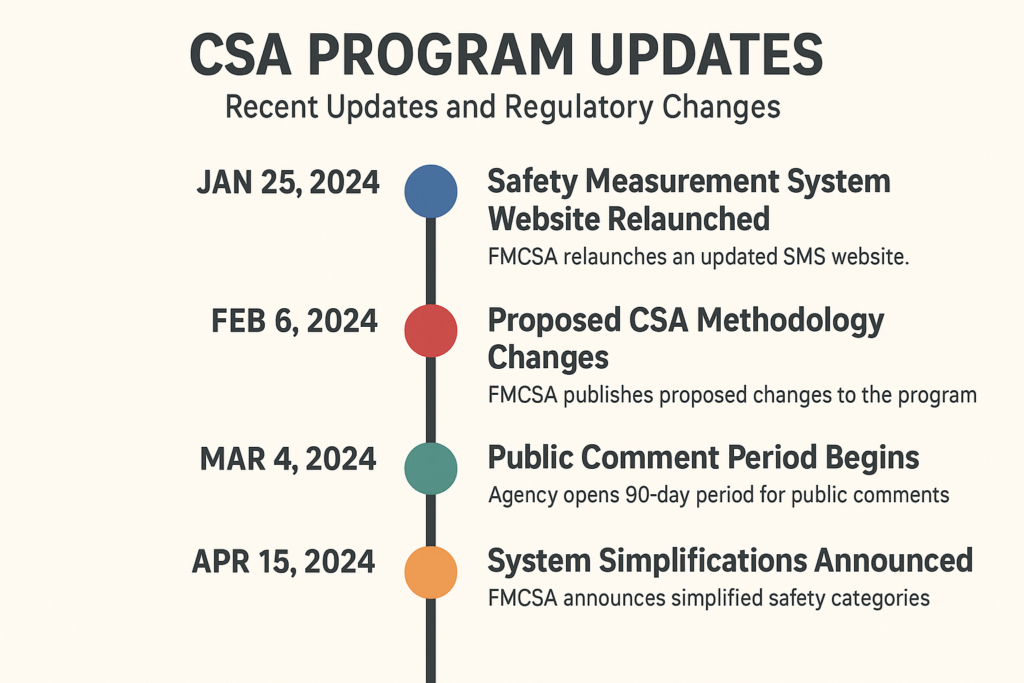Did you know that a single poor CSA score can increase your trucking company’s insurance premiums by up to 30%? That’s just one shocking reality of the Compliance, Safety, Accountability program that’s reshaping the trucking industry! If you’re a fleet owner, driver, or safety manager, understanding CSA scores isn’t just important—it’s absolutely critical for your business survival.
The Federal Motor Carrier Safety Administration’s CSA program has become the backbone of trucking safety enforcement since its implementation. Every inspection, violation, and crash gets recorded and calculated into scores that can make or break your operation. Whether you’re running a single truck or managing a massive fleet, these scores directly impact everything from your bottom line to your ability to secure contracts with major shippers.

CSA scores represent the heart of modern trucking safety enforcement. The Compliance, Safety, Accountability program replaced the outdated SafeStat system, creating a more comprehensive and data-driven approach to motor carrier safety evaluation. These scores aren’t just numbers on a report—they’re the key metrics that determine your company’s future in the transportation industry.
When we talk about CSA scores, we’re referring to percentile rankings that compare your safety performance against other carriers of similar size and type. The program uses a sophisticated algorithm that weighs violations, inspections, and crashes over a 24-month period. Lower scores are better, with anything above the 50th percentile potentially triggering federal intervention.
The real-world impact of CSA scores extends far beyond regulatory compliance. Insurance companies use these scores to set premiums, often resulting in significant cost increases for carriers with poor safety records. Major shippers and brokers frequently require specific CSA score thresholds before considering partnerships, making these scores a direct gateway to business opportunities.
Poor CSA performance can trigger DOT audits, which consume valuable time and resources while potentially leading to more severe enforcement actions. In extreme cases, carriers may face out-of-service orders that completely shut down operations until compliance issues are resolved.
“The difference between a 30th percentile and 70th percentile CSA score can mean the difference between thriving and surviving in trucking. In an industry where margins are tight, your safety record is your competitive advantage.”

The Safety Measurement System evaluates carriers across seven Behavior Analysis and Safety Improvement Categories (BASICs), each targeting specific safety behaviors and compliance areas.
Focuses on dangerous driving behaviors that increase crash risk. This category includes violations like speeding, reckless driving, improper lane changes, and following too closely. Each violation receives severity points based on the specific infraction, with more dangerous behaviors carrying higher point values.
It doesn’t just count crashes—it analyzes their severity and circumstances. The system considers factors like fatalities, injuries, and whether the commercial vehicle was deemed at fault. This category helps identify carriers with higher crash rates relative to their exposure.
Monitors adherence to federal driving time regulations. With electronic logging devices now mandatory, this category has become increasingly important. Violations include exceeding daily driving limits, inadequate rest periods, and logbook falsification.
Evaluates how well carriers maintain their equipment. DOT inspections reveal defects in brakes, tires, lighting, and other critical systems. This category emphasizes the connection between proper maintenance and road safety.
focuses on drug and alcohol program compliance. This includes pre-employment testing, random programs, post-accident testing, and return-to-duty processes. The Drug and Alcohol Clearinghouse has made this category even more critical for carrier compliance.
It applies to carriers transporting hazardous materials. This specialized category covers proper placarding, security plans, driver training, and packaging requirements. Only carriers with hazmat authority are evaluated in this category.
It ensures drivers meet federal qualification standards. This includes proper licensing, medical certification, and maintaining accurate driver qualification files. Recent emphasis on medical examiner certification has made this category increasingly important.

Understanding CSA score calculation helps carriers identify improvement opportunities and predict the impact of violations on their safety ratings. The Safety Measurement System uses a time-weighted approach that emphasizes recent violations while considering historical performance.
The system operates on a 24-month evaluation period, but violations aren’t weighted equally throughout this timeframe. Recent violations carry more weight than older ones, reflecting the belief that recent performance better predicts future behavior. Violations in the most recent six months receive full weight, while older violations receive progressively less weight.
Severity weighting ensures that more serious violations have greater impact on scores. A violation involving a crash or dangerous condition receives higher severity points than a minor paperwork infraction. This approach focuses attention on behaviors most likely to cause accidents or injuries.
Once violation data is collected and weighted, the system calculates percentile rankings by comparing each carrier’s performance to others in similar groups. These percentiles become the CSA scores that determine intervention thresholds and enforcement actions.

Regular CSA score monitoring is essential for proactive safety management. The FMCSA provides free access to safety data through the Safety Measurement System website, allowing carriers to track their performance and identify trends.
To access your CSA scores, visit the FMCSA SMS website and search for your company using your DOT number or company name. The system provides detailed reports showing your percentile rankings across all applicable BASIC categories, along with violation history and inspection results.
Your Safety Measurement System report contains valuable information beyond just percentile rankings. It shows violation counts, inspection dates, and specific infractions that contributed to your scores. This detailed breakdown helps identify patterns and prioritize improvement efforts.
Setting up automated monitoring ensures you stay informed about score changes without constantly checking the website. Several third-party services provide alert systems that notify you when scores change or approach intervention thresholds. These services often include additional analytics and benchmarking features.
Understanding industry benchmarks helps put your scores in perspective. Average CSA scores vary by industry segment, with some sectors historically performing better than others. Comparing your performance to relevant peer groups provides more meaningful context than looking at scores in isolation.
Regular score reviews should be part of your safety management routine. Monthly monitoring allows you to identify trends before they become problems and demonstrate proactive safety management to regulators, insurers, and customers.

Improving CSA scores requires a comprehensive approach that addresses all aspects of fleet safety management. The most successful carriers develop systematic programs that prevent violations rather than simply reacting to enforcement actions.
Forms the foundation of CSA improvement. Comprehensive training programs should cover both initial qualification and ongoing professional development. Focus on areas directly related to your worst-performing BASIC categories, whether that’s hours of service compliance, vehicle inspection procedures, or hazmat regulations.
Pre-trip and post-trip inspection training is particularly important for improving the Vehicle Maintenance BASIC. Drivers who can identify and report defects before they become violations help prevent roadside out-of-service orders and reduce maintenance-related CSA points.
It goes beyond basic compliance to create preventive maintenance programs that keep equipment in optimal condition. Regular inspection schedules, predictive maintenance technologies, and thorough documentation help identify issues before they become violations.
Working with qualified maintenance providers ensures repairs meet federal standards and are properly documented. Maintaining detailed maintenance records also supports your defense if violations are contested or questioned during audits.
It has become increasingly important with electronic logging device requirements. Implement dispatch and driver management systems that help prevent violations before they occur. This includes trip planning tools, driver scheduling software, and real-time monitoring capabilities.
It creates an environment where safety is valued and rewarded. This involves leadership commitment, clear policies and procedures, regular safety meetings, and recognition programs for safe performance. A strong safety culture reduces violations across all BASIC categories.
Technology significantly improve CSA performance through real-time monitoring, automated alerts, and data analytics. Telematics systems provide insights into driver behavior, vehicle performance, and compliance status that help prevent violations.

Understanding the consequences of poor CSA performance motivates carriers to prioritize safety improvement and helps justify investment in compliance programs. The FMCSA uses a progressive enforcement approach that escalates based on score severity and duration.
Trigger when carriers exceed specific percentile rankings in BASIC categories. These thresholds vary by category but generally fall between the 50th and 85th percentiles. Once triggered, carriers may receive warning letters, be subject to targeted investigations, or face comprehensive safety audits.
Represent the first formal enforcement action for most CSA violations. These letters identify specific safety concerns and may require written responses detailing corrective actions. While not immediately punitive, warning letters create an enforcement record that influences future actions.
Examine specific areas of concern identified through CSA scores. These audits are more limited in scope than comprehensive reviews but can still result in serious consequences if violations are found. Audits often focus on the highest-scoring BASIC categories.
Examine all aspects of a carrier’s safety management system. These intensive reviews can take days or weeks to complete and may result in safety rating downgrades, penalty assessments, or operating restrictions.
Often prove more immediately impactful than federal enforcement actions. Many insurance companies use CSA scores to set premiums, with poor scores resulting in significant cost increases or policy cancellations. Some insurers impose surcharges or require additional safety measures for carriers with elevated scores.
Have become increasingly common as shippers and brokers use CSA scores to evaluate potential partners. Many major companies require specific CSA score thresholds or exclude carriers with poor safety records from their approved provider lists.
Represent the most severe consequence, immediately prohibiting carriers from operating until compliance issues are resolved. These orders can result from severe violations, repeated non-compliance, or safety rating downgrades.

The CSA program continues evolving as the FMCSA refines its approach to safety enforcement and responds to industry feedback. Staying current with these changes is essential for effective compliance management.
Recent FMCSA rule modifications have addressed several long-standing industry concerns about CSA scoring methodology. The agency has proposed changes to how violations are weighted and how carriers are grouped for comparative analysis. These modifications aim to create more equitable scoring across different carrier types and operating environments.
Have created scoring inconsistencies that the FMCSA is working to address. Some states focus heavily on specific violation types, while others emphasize different safety areas. The agency is developing approaches to account for these variations in future scoring updates.
Continues expanding with new requirements for electronic logging devices and drug and alcohol testing programs. The Drug and Alcohol Clearinghouse has significantly impacted the Controlled Substances/Alcohol BASIC, making this category more critical for carrier compliance.
Is being integrated more extensively into CSA scoring, providing more accurate hours of service violation detection. This change has increased the importance of proper ELD training and compliance procedures.
has led to several scoring methodology adjustments. The FMCSA has been more responsive to carrier concerns about unfair scoring practices and has implemented several changes to address these issues.
for 2025 include potential modifications to how crashes are weighted in scoring calculations and adjustments to intervention thresholds. The agency continues studying these changes to ensure they improve safety outcomes without creating unnecessary compliance burdens.

Effective CSA score management requires the right tools and resources to monitor performance, identify improvement opportunities, and maintain compliance. The marketplace offers numerous solutions designed specifically for fleet safety management.
Provides comprehensive CSA monitoring and management capabilities beyond what’s available through the FMCSA website. These platforms typically offer real-time score monitoring, violation tracking, and predictive analytics to help carriers stay ahead of potential problems.
Popular compliance software solutions include features like automated alert systems, violation trend analysis, and compliance calendar management. Many platforms integrate with existing fleet management systems to provide seamless data flow and reduce administrative burden.
Help track individual driver performance across CSA-related metrics. These systems can identify drivers who may need additional training or support and help recognize top performers. Some platforms include gamification elements to encourage safe driving behaviors.
should include procedures for contesting inaccurate violations through the DataQs system. This FMCSA-operated system allows carriers to challenge violations they believe were issued incorrectly or unfairly. Successful challenges can improve CSA scores and reduce enforcement consequences.
Are available through various industry organizations, training companies, and government agencies. The FMCSA provides free training materials through its website, while organizations like the American Trucking Associations offer comprehensive safety programs.
Provide valuable support for CSA compliance efforts. Organizations like the Owner-Operator Independent Drivers Association (OOIDA) and various state trucking associations offer resources, training, and advocacy on CSA-related issues.
opportunities help safety managers stay current with CSA requirements and best practices. Certifications from organizations like the National Safety Council or National Association of Safety Professionals can enhance safety management capabilities.
Managing your CSA scores isn’t just about regulatory compliance—it’s about building a sustainable, profitable trucking business that stands the test of time. The strategies we’ve covered will help you transform your safety culture and protect your bottom line. Remember, every violation avoided is money saved, and every improved score opens new opportunities for growth.
The trucking industry’s competitive landscape makes CSA score management more critical than ever. Carriers with excellent safety records enjoy lower insurance costs, better customer relationships, and reduced regulatory scrutiny. These advantages translate directly into improved profitability and business sustainability.
Don’t wait until poor CSA scores threaten your operation! Start implementing these proven strategies today, and make 2025 the year your trucking company achieves excellence in safety performance. Your drivers, customers, and bank account will thank you for taking proactive steps toward CSA score improvement.
Remember that CSA score improvement is an ongoing process, not a one-time project. Regular monitoring, continuous improvement, and proactive safety management create the foundation for long-term success in today’s trucking industry. The investment you make in safety today will pay dividends through reduced costs, improved opportunities, and enhanced reputation for years to come.
Ready to improve your CSA scores? Contact our safety consultants for a comprehensive fleet safety assessment and customized improvement plan tailored to your specific needs and challenges.
This comprehensive guide provides the foundation for CSA score improvement, but every fleet’s needs are unique. Consider working with qualified safety consultants to develop customized strategies that address your specific challenges and opportunities.
We’re here to keep your trucking business moving forward. Reach out to us with any inquiries, service requests, or partnership opportunities. Let’s grow together!

Let Clear Path Trucking LLC. be your trusted partner in navigating the road to success. Whether you’re an owner-operator or managing a fleet, we’re here to help you take your trucking business to the next level.
Subscribe to receive industry updates and tips directly in your inbox
© Copyright 2024 Clear Path Trucking LLC. - All Rights Reserved.